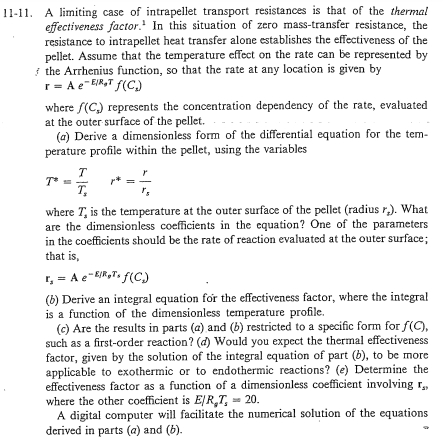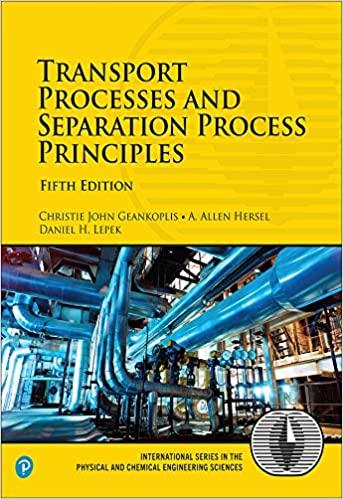Answered step by step
Verified Expert Solution
Question
1 Approved Answer
Q . 1 1 . 1 1 Smith. 1 1 - 1 1 . Un caso limitante de las resistencias al transporte intrapellet es el
Q Smith. Un caso limitante de las resistencias al transporte intrapellet es el del factor de efectividad trmica En esta situacin de resistencia cero a la transferencia de masa, la resistencia a la transferencia de calor dentro del pellet establece por s sola la eficacia del pellet. Supongamos que el efecto de la temperatura sobre la tasa se puede representar mediante la funcin de Arrhenius, de modo que la tasa en cualquier ubicacin est dada por rAeERT C
donde C representa la dependencia de la concentracin de la tasa, evaluada en la superficie exterior del pellet.
a Deduzca una forma adimensional de la ecuacin diferencial para el perfil de temperatura dentro del pellet, utilizando las variables
T donde es la temperatura en la superficie exterior del pellet radio rCules son los coeficientes adimensionales en la ecuacin Uno de los parmetros de los coeficientes debera ser la velocidad de reaccin evaluada en la superficie exterior; es decir, AeERT C
Derive una ecuacin integral para el factor de efectividad, donde la integral es una funcin del perfil de temperatura adimensional.
cLos resultados de los incisos a y b estn restringidos a una forma especfica para fC como una reaccin de primer orden? dEsperara que el factor de efectividad trmica dado por la solucin de la ecuacin integral del inciso b fuera ms aplicable a reacciones exotrmicas o endotrmicase Determine el factor de efectividad en funcin de un coeficiente adimensional que involucra r donde el otro coeficiente es ERTUna computadora digital facilitar la solucin numrica de las ecuaciones derivadas de los incisos a y b
A limiting case of intrapellet transport resistances is that of the thermal
effectiveness factor. In this situation of zero masstransfer resistance, the
resistance to intrapellet heat transfer alone establishes the effectiveness of the
pellet. Assume that the temperature effect on the rate can be represented by
the Arrhenius function, so that the rate at any location is given by
where represents the concentration dependency of the rate, evaluated
at the outer surface of the pellet.
a Derive a dimensionless form of the differential equation for the tem
perature profile within the pellet, using the variables
where is the temperature at the outer surface of the pellet radius What
are the dimensionless coefficients in the equation? One of the parameters
in the coefficients should be the rate of reaction evaluated at the outer surface;
that is
b Derive an integral equation for the effectiveness factor, where the integral
is a function of the dimensionless temperature profile.
c Are the results in parts a and b restricted to a specific form for
such as a firstorder reaction? d Would you expect the thermal effectiveness
factor, given by the solution of the integral equation of part b to be more
applicable to exothermic or to endothermic reactions? e Determine the
effectiveness factor as a function of a dimensionless coefficient involving
where the other coefficient is
A digital computer will facilitate the numerical solution of the equations
derived in parts and

Step by Step Solution
There are 3 Steps involved in it
Step: 1

Get Instant Access to Expert-Tailored Solutions
See step-by-step solutions with expert insights and AI powered tools for academic success
Step: 2

Step: 3

Ace Your Homework with AI
Get the answers you need in no time with our AI-driven, step-by-step assistance
Get Started


